Best Automated Trading Strategies 2024
What is an automated trading system?
An automated trading system is a set of rules that can be programmed for a computer to automatically execute trades whenever the rules occur in a given financial market. An automated trading system is the same thing as an automated trading strategy, an algo strategy, a trading algorithm, a trading robot or an algorithmic trading strategy.
In short, any pre-determined set of buy and sell rules that can execute trades automatically can be considered an automated trading system. Trading rules can be any set of if then scenarios and do not need to be complicated mathematical models.
Simple Automated Trading System Example
The simplest automated trading strategy is a moving average cross strategy. This system buys when the stock price rises above the moving average and sells when the stock price falls below the moving average.
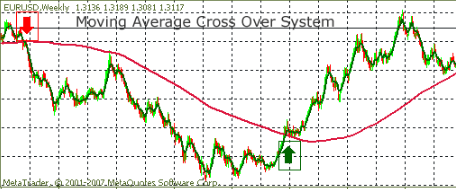
Algorithmic traders have long known this strategy to lose its luster in financial markets, but this system is a great example of how simple buy or sell decisions can be made using technical indicators or market prices. If you can think it, then it can be coded.
Later we will get into much more complex algorithmic trading strategies and trading algorithms. However, I will not go into black box trading where strategies are known to the computer but not known to the human in charge of the computer.
How Does Algorithmic Trading Work?
Algorithmic trading works over the internet allowing one computer or server to receive market data and send trading instructions to another computer or server. For instance, a high frequency trading firm may have their servers co-located in the exchange’s data center. This allows for lower latency in receiving new market prices and issuing new orders.
This server can also calculate the trading strategies and send buy and sell orders directly to the exchange. The exchange parses the message and executes the market makers’ desired actions.
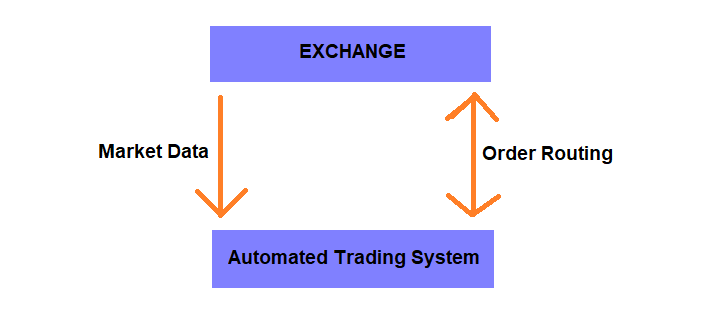
Most trading systems communicate with the exchange through Financial Information Exchange protocol or FIX protocol. However, many independent traders have brokers that provide this communication connection built into the platform and most traders never have to worry about how algorithmic trading works.
Most platforms, brokers, and software provide application programming interfaces or APIs that make it easy to connect custom code to the exchange or broker. However, software like Build Alpha or TradeStation make it possible to connect directly with data providers, brokers, and the exchanges so traders only have to worry about entries, exits and risk management.
What are different types of automated trading systems?
There are various different types of trading strategies but let’s cover the five most popular strategies below. These strategies can apply for longer term investors or day traders. For a more extensive look please check out my Algorithmic Trading Guide.
Momentum or Trend Following
Arguably the simplest and most widely used – especially amongst commodity traders. Trend following strategies aim to capture prolonged price movement in a single direction or a “trend”.
Trend strategies tend to have lower win percentages as these strategies have outsized winners in comparison to more frequent but smaller losers. The typical returns from a trend strategy may be a series of small losses and then one large win when the system captures the large trend move.
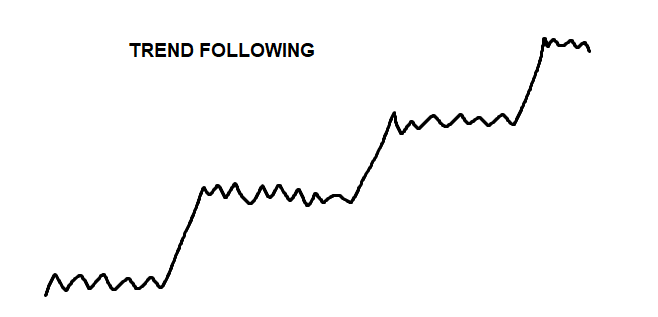
These strategies are best implemented by traders with strong resolve and the ability to withstand frequent losses. Periods of chop and noise are much more common than big trend moves thus leading to your trading account not making much progress most of the time and then making large leaps “at once”.
Mean Reversion
Mean reversion trading strategies tend to have higher win percentages as they have many frequent small wins and the infrequent large loss. The typical returns from a mean reversion strategy may be a series of small wins and then one large loss when the trend breaks.
The simplest mean reversion strategy is one that aims to buy and sell large deviations from a moving average or volume weighted average price. As price moves away from the mean, however calculated, the strategy looks to enter a position with the intention of price returning to the average price.
Many traders refer to these extremes as overbought or oversold and attempt to quantify them with technical analysis, technical indicators, mathematical models or statistical concepts.
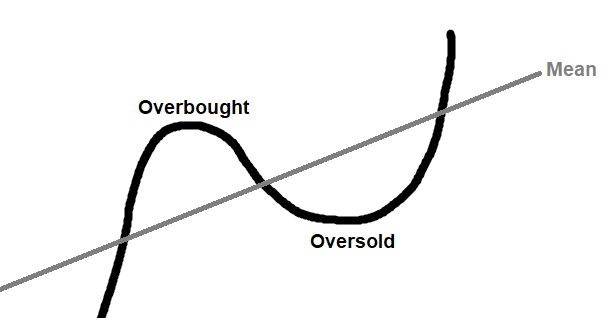
In theory, traders that employ mean reversion strategies can experience profit and loss of their trading account to inch higher most of the time with periodic large set backs. Many market makers and dealers experience this.
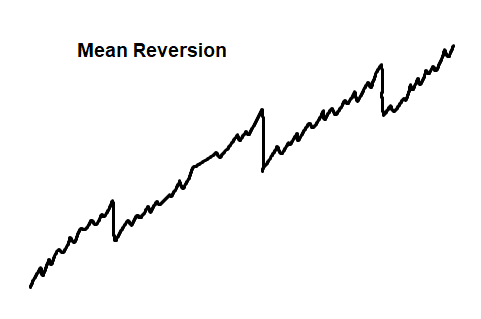
Statistical Arbitrage
Typically, statistical arbitrage is looking for short-lived opportunities between two securities. Many traders will isolate two correlated or related stocks such as Coca-Cola and Pepsi and monitor the spread or difference between the two. Whenever the difference between the two becomes large enough the trader places a trade buying the cheaper and shorting the expensive until the pairing comes back into normal ranges.
An obvious simplification, but many traders cannot execute pair trading or statistical arbitrage with retail brokerage accounts and software. There is also steep competition from professionals, market makers and hedge funds.
Market Making and High Frequency Trading
A market maker can be thought of as a liquidity provider that quotes both bids and offers regardless of market conditions. The market maker will hold inventory and aims to profit on the bid-ask spread or the difference between the highest price someone is willing to buy and the lowest price someone is willing to sell.
Market making is arguably the most complex form of algorithmic trading and automated trading as it requires tons of price data, quote information, data from multiple stock exchanges, active trading activities and trading decisions and is often completely automated with zero room for discretion.
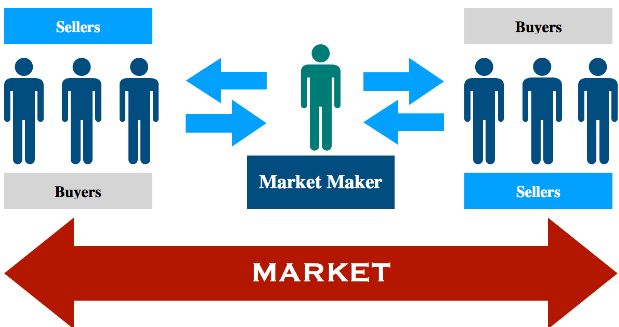
High frequency trading (HFT) is market making or trading in fractions of a second based on powerful computer programs executing large numbers of orders almost simultaneously. The depths, pros and cons, and nuances of HFT and market making far exceed the scope of this post.
Pattern Trading
In the previously mentioned Algorithmic Trading Guide, I mention pattern trading as being one of the most common strategy types for algorithmic traders. This style was popularized by Jaffray Woodriff of Quantitative Investment Management in Jack Schwager’s Hedge Fund Market Wizards book (still one of my favorites).
This style looks for repeatable patterns that shift the odds one way or the other. For example, based on historical data, whenever this candlestick formation or these two events have occurred there has been a X% chance price is higher over the next N days. Again, a gross simplification, but a trading style most traders are familiar.
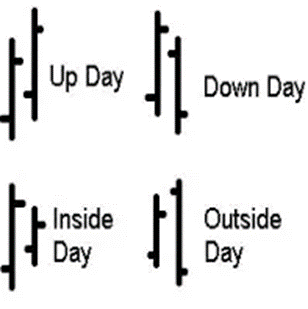
Is Automated Trading Profitable?
Yes. The leading 12 investment banks earned about $2 billion from portfolio and algorithmic trading in 2020 according to Coalition Greenwich. Additionally, the greatest hedge fund of all time – Renaissance Technologies – is strictly algorithmic. Listen to James Simons, the founder, speak from 36:48 to 38:00.
James Simons (full length interview) – Numberphile – YouTube
Furthermore, I have posted tons of algo trading success stories on the Build Alpha blog. Successful automated trading requires rigorous testing, robustness tests, stress testing, considering multiple market conditions, contextual data and more. Nothing manual trading does not require. I wrote a bit about strategy reliability here: Robustness Testing for Trading Strategies.
Can I automate my trading strategy?
Yes. We live in the golden age of algo trading as nearly 75% of US equity volume now comes from algorithms while algorithmic trading is expected to grow at 11.23% CAGR over the next five years. Brokers and data platforms have made trade automation incredibly simple.
My goal with Build Alpha has been to connect those with a desire to automate trading strategies with the tools to do so without having to learn or write any code. Now anyone can test, build and automate their trading strategies without any code.
What’s the best automated trading software?
Build Alpha is the best automated trading software. I am biased because as I set out to find the best automated trading software, I could not find one that gave me the end-to-end tools necessary. That is what prompted Build Alpha’s development oh so many years ago. That being said, I will review the three most popular software for automated trading strategies.
Build Alpha
Build Alpha enables traders to create, test, and automate trading strategies with no code. There are 5,000+ built-in entry and exit signals as well as the ability for users to add their own signals with a drag and drop builder. The signal library includes everything from seasonality, price action, candlesticks, chart patterns, technical indicators, market breadth, options flows, economic data, time of day and more.
Build Alpha works in two ways. First, the trader can select specific entry and exit signals from the point-and-click interface to test a specific strategy. On the other hand, Build Alpha’s genetic algorithm can take thousands of inputs such as potential entries, exits, filters, risk management, position sizing, account size and will build the best possible strategies.
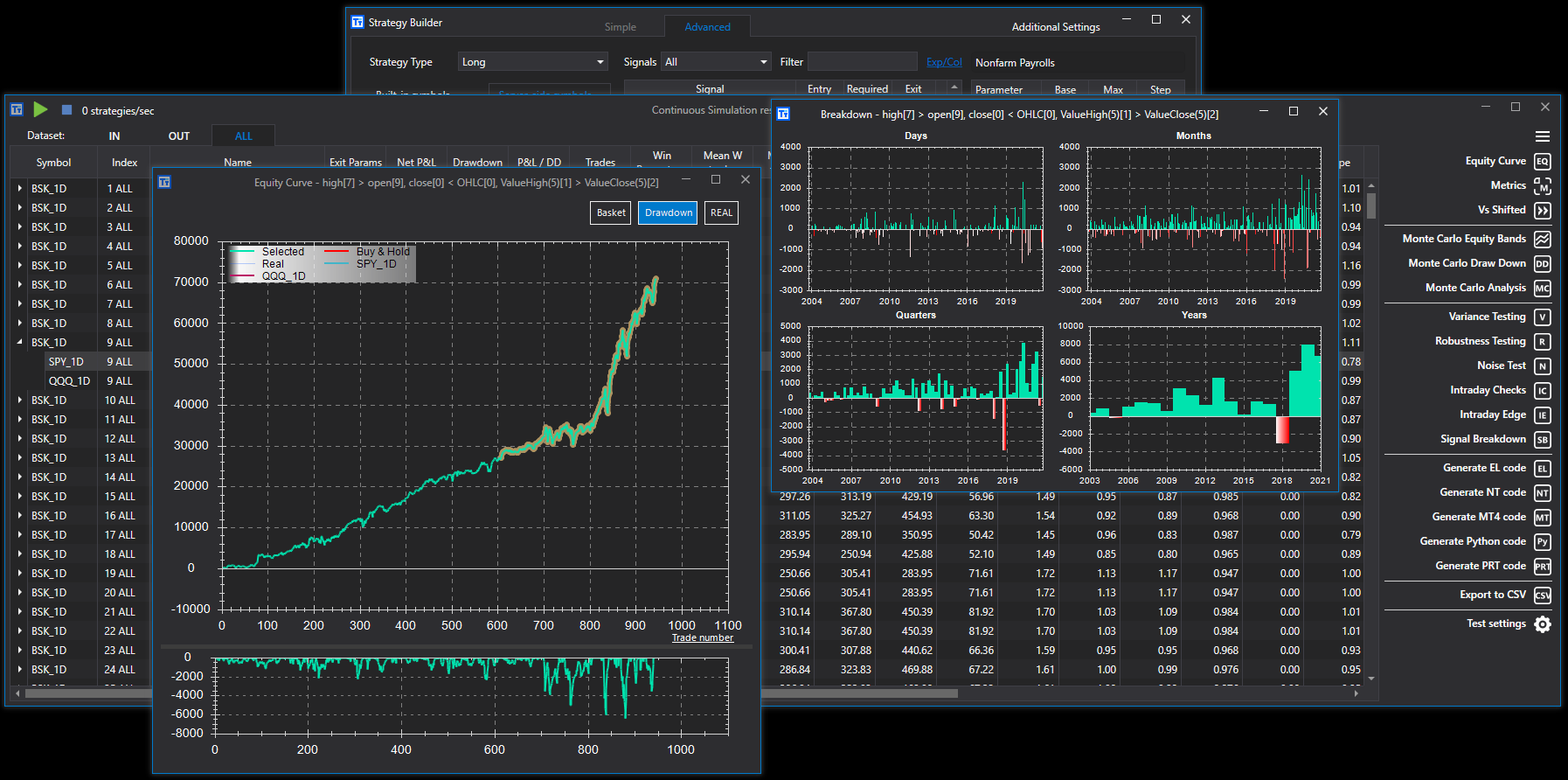
The trader can also specify certain thresholds that each strategy must pass such as the Monte Carlo simulation must be profitable or the profit factor must be above 1.7, etc. These automated workflows allow for the fast creation of strategies that fit any trader’s desired risk tolerance and performance thresholds.
Build Alpha then connects to live market prices for real-time strategy monitoring or can produce fully automatable code for every strategy. This code can be copy and pasted into various broker platforms for live trading.
Take a look at these to see step-by-step walkthroughs
TradeStation
TradeStation makes automating trading strategies very simple as TradeStation is a broker and has a really reliable platform which is a favorite among independent algorithmic traders. TradeStation also created Easy Language, a proprietary programming language aimed to make trading strategy development much simpler for traders.
Traders can write their strategy logic using Easy Language inside TradeStation’s Development Environment. Once the strategy’s code is complete, the trader can easily add the strategy to a chart to enable simulated or live trading.
A simple moving average crossover strategy may only require two lines of code using Easy Language. Here is an example below:
If Close crosses above average(close,10) then buy 100 shares next bar open;
If Close crosses below average(close,10) then sell 100 shares next bar open;For those of you interested in a TradeStation account, email me to find out how TradeStation will pay for your Build Alpha license.
Python
Python is undoubtedly the fastest growing programming language due to its easy-to-read syntax and clean scripting style. Many traders have flocked to python as the vast number of public libraries that have already built trading functionality such as technical indicators and other position sizing logic coded continues to grow.
If you are interested in learning about using python to build automated trading strategies, then I highly recommend checking out a few other resources I have created.
- Create Automated Strategies Using Excel, Python and Build Alpha
- Using Python in Build Alpha
- Python Tips and Tricks for Text Files and Plotting
How to create a trading algorithm in 3 Steps with Build Alpha
Build Alpha is the simplest way to create algorithmic trading strategies as it does not require any coding. Let’s take the moving average cross strategy above and build it in 3 clicks.
Step 1 – Select Signals
Search for SMA signals and select an entry and exit. Let’s enter when the close crosses above the 10-period SMA and exit when the close crosses above the 10-period SMA.

Yes, you can optimize parameters. I am showing the lazy hardcoded settings. Traders can create any range of parameters to test and optimize.
Step 2 – Select Dates and Symbol(s)
Select your test dates, symbol(s), and any risk management. I will select SPY and test from 2006 to 2022.

Step 3 – Simulate
Hit Simulate and view your results. If the results are suitable (they should not be) then hit one of the “Generate Code” buttons to get fully automatable code for this (or any) strategy.

It is important to note that Build Alpha permits automated trading strategy monitoring in two ways. First, you can export generated code. Second, you can connect your broker’s data feed with existing connections to TradeStation, Interactive Brokers, QuoteMedia, Binance, and more.
Example Automated Trading Strategy
Later in this post I will share a table that automatically updates with the best technical analysis strategies for all financial markets. Each strategy uses one rule for entry and one rule for exit. These are meant to give insights to what is working now, building blocks for your own strategies, and general free information.
This strategy below has two rules: one for entry and one for exit. The trading strategy is applied to CSCO or Cisco Systems Inc which is a large multinational technology conglomerate.

This strategy enters when the closing price crosses below the 5-period exponential moving average (EMA) and exits when the closing price crosses above the 5-period exponential moving average.
At the time of publishing, you can see a sample of this strategy’s performance on the far right over the past 1,809 trades earning $18,138.17 per 100 shares traded over the last 12 months. This strategy also would have made $1,883.81 over the last 30 days.
What are the best automated trading strategies right now?
First, how do we define best? The simplest way is total P&L. Second, what is a trading strategy? In this case, let’s look at all possible combinations of technical indicators and only use one rule for entry and one rule for exit.
Can we build more advanced systems? Yes. However, this results table serves to show us what parameter settings, lookback ranges and indicators have been performing well lately. Perhaps this info can serve as building blocks for new automated trading strategies or just free information for my fellow system traders.
In the table below, you can sort by asset class, timeframe, ticker, and minimum trade count. All strategies are sorted by their total profit and loss over the last 30 days and last 12 months. All strategies use the same position sizing.
Key Points
- Automated trading systems automatically execute buy and sell orders based on pre-defined rules.
- There are at least 5 different types of algorithmic trading strategies
- Trend Following
- Mean Reversion
- Statistical Arbitrage
- Market Making / High Frequency Trading
- Pattern Trading
- It has never been easier to automate trading strategies – even with no programming
- Build Alpha, TradeStation and Python are easier routes to algo trading
- The best trading strategies are changing all the time, but the table above is free to all
Summary
Automated trading strategies continue to grow in popularity as traders with no programming background can now turn their strategies into trading algorithms. Automated trading strategies are just pre-defined rules that instruct a computer when and how much to buy and sell in financial markets. I have spent the past decade involved in professional trading and can honestly answer there is no best automated trading strategy. However, a combination of robustness testing and portfolio construction can help any trader gain an edge in algorithmic trading over the trader that fails to grasp these algorithmic trading concepts.
Author
David Bergstrom – the guy behind Build Alpha. I have spent a decade-plus in the professional trading world working as a market maker and quantitative strategy developer at a high frequency trading firm with a Chicago Mercantile Exchange (CME) seat, consulting for Hedge Funds, Commodity Trading Advisors (CTAs), Family Offices and Registered Investment Advisors (RIAs). I am a self-taught programmer utilizing C++, C# and python with a statistics background specializing in data science, machine learning and trading strategy development. I have been featured on Chatwithtraders.com, Bettersystemtrader.com, Desiretotrade.com, Quantocracy, Traderlife.com, Seeitmarket.com, Benzinga, TradeStation, NinjaTrader and more. Most of my experience has led me to a series of repeatable processes to find, create, test and implement algorithmic trading ideas in a robust manner. Build Alpha is the culmination of this process from start to finish. Please reach out to me directly at any time.
Risk Disclosure
Futures And Forex Trading Contains Substantial Risk And Is Not For Every Investor. An Investor Could Potentially Lose All Or More Than The Initial Investment. Risk Capital Is Money That Can Be Lost Without Jeopardizing Ones Financial Security Or Life Style. Only Risk Capital Should Be Used For Trading And Only Those With Sufficient Risk Capital Should Consider Trading. Past Performance Is Not Necessarily Indicative Of Future Results.
Hypothetical Performance Disclaimer
Hypothetical Performance Results Have Many Inherent Limitations, Some Of Which Are Described Below. No Representation Is Being Made That Any Account Will Or Is Likely To Achieve Profits Or Losses Similar To Those Shown; In Fact, There Are Frequently Sharp Differences Between Hypothetical Performance Results And The Actual Results Subsequently Achieved By Any Particular Trading Program. One Of The Limitations Of Hypothetical Performance Results Is That They Are Generally Prepared With The Benefit Of Hindsight. In Addition, Hypothetical Trading Does Not Involve Financial Risk, And No Hypothetical Trading Record Can Completely Account For The Impact Of Financial Risk Of Actual Trading. For Example, The Ability To Withstand Losses Or To Adhere To A Particular Trading Program In Spite Of Trading Losses Are Material Points Which Can Also Adversely Affect Actual Trading Results. There Are Numerous Other Factors Related To The Markets In General Or To The Implementation Of Any Specific Trading Program Which Cannot Be Fully Accounted For In The Preparation Of Hypothetical Performance Results And All Which Can Adversely Affect Trading Results.
Automated Software for Trading | How to Develop a Trading Strategy | Best Automated Trading Systems Software| Algorithmic Trading Strategies | How to Build a Trading System | Creating a Trading Strategy | Trading Strategies Software
Build Alpha Automated Trading System Builder. Creates, tests, and codes algorithmic trading strategies with NO programming
- Telephone: 561-203-9143
- Email: david@buildalpha.com
- Build Alpha © 2021
